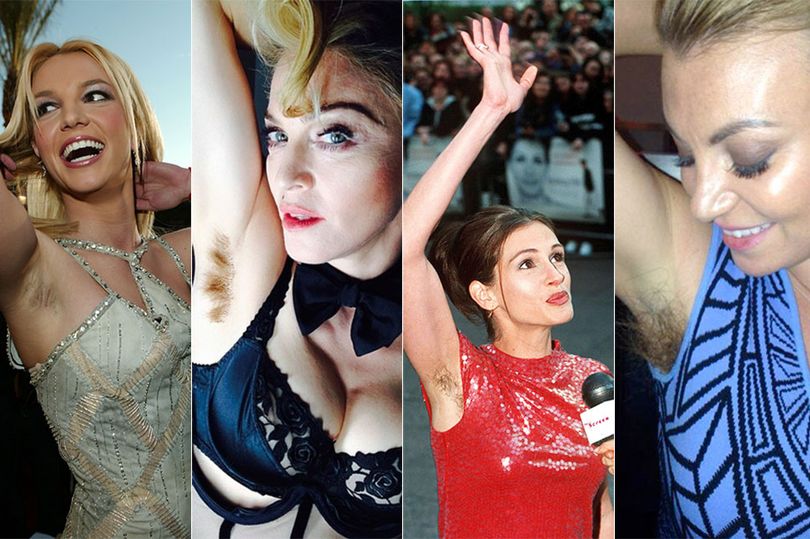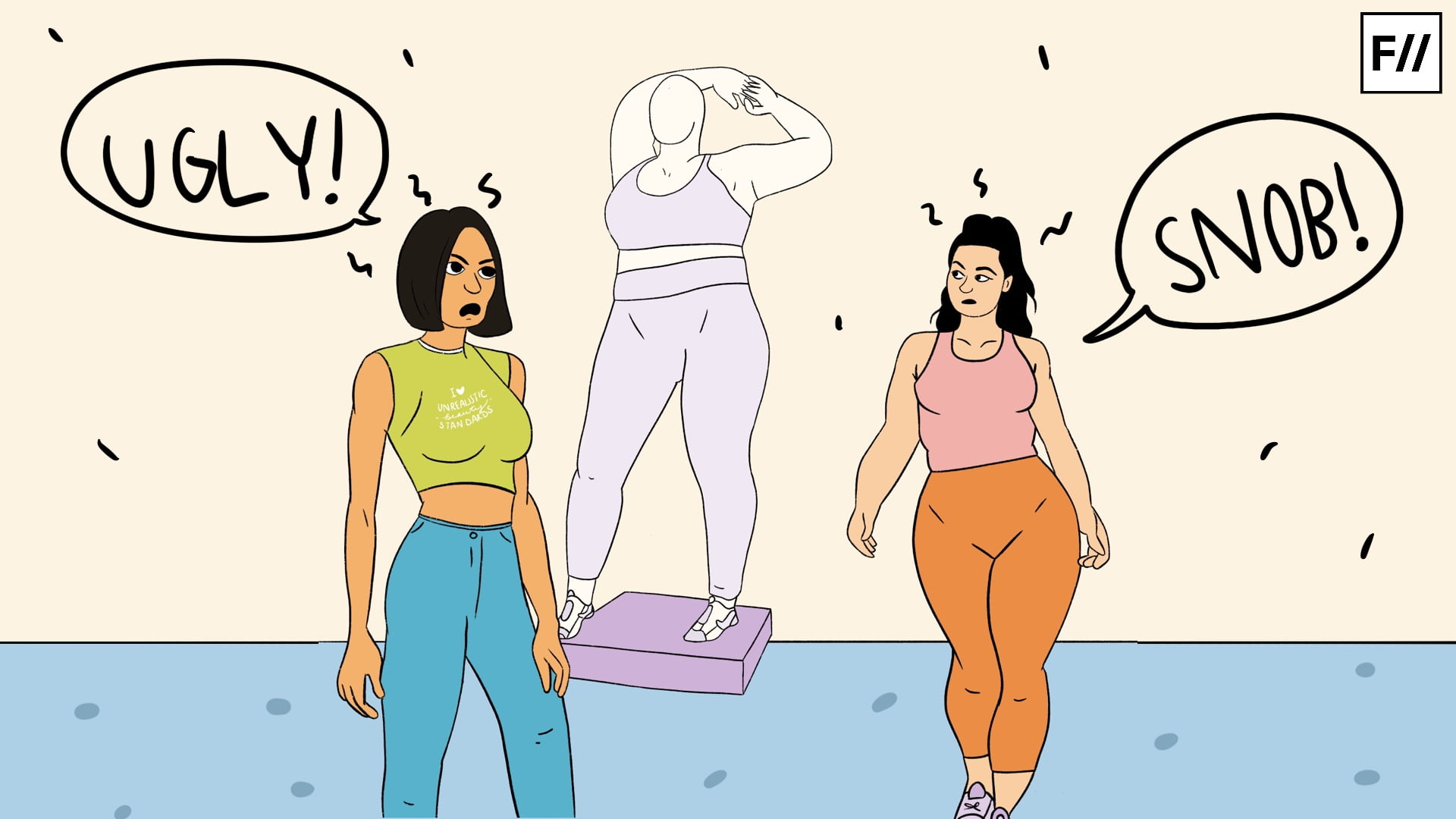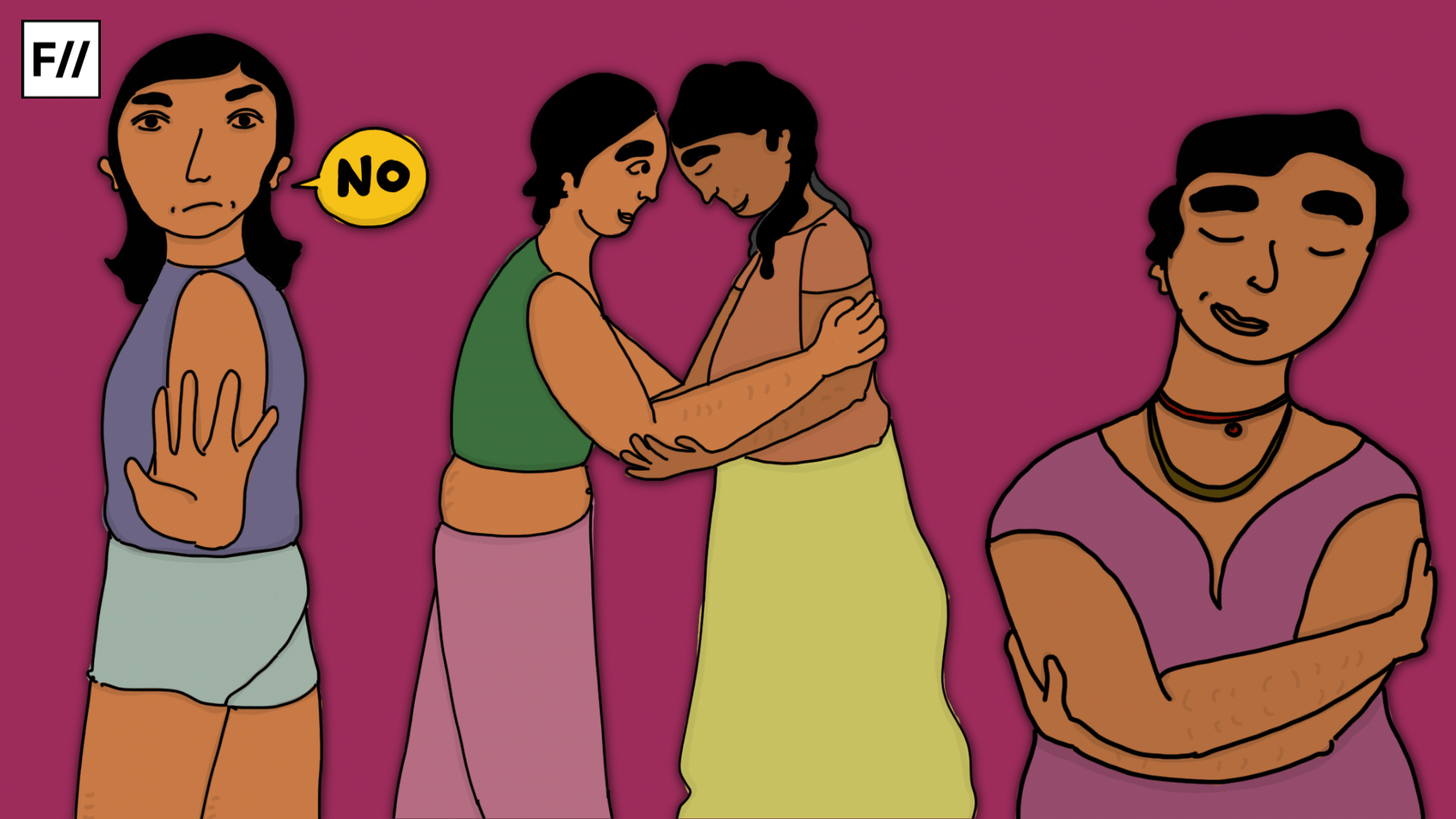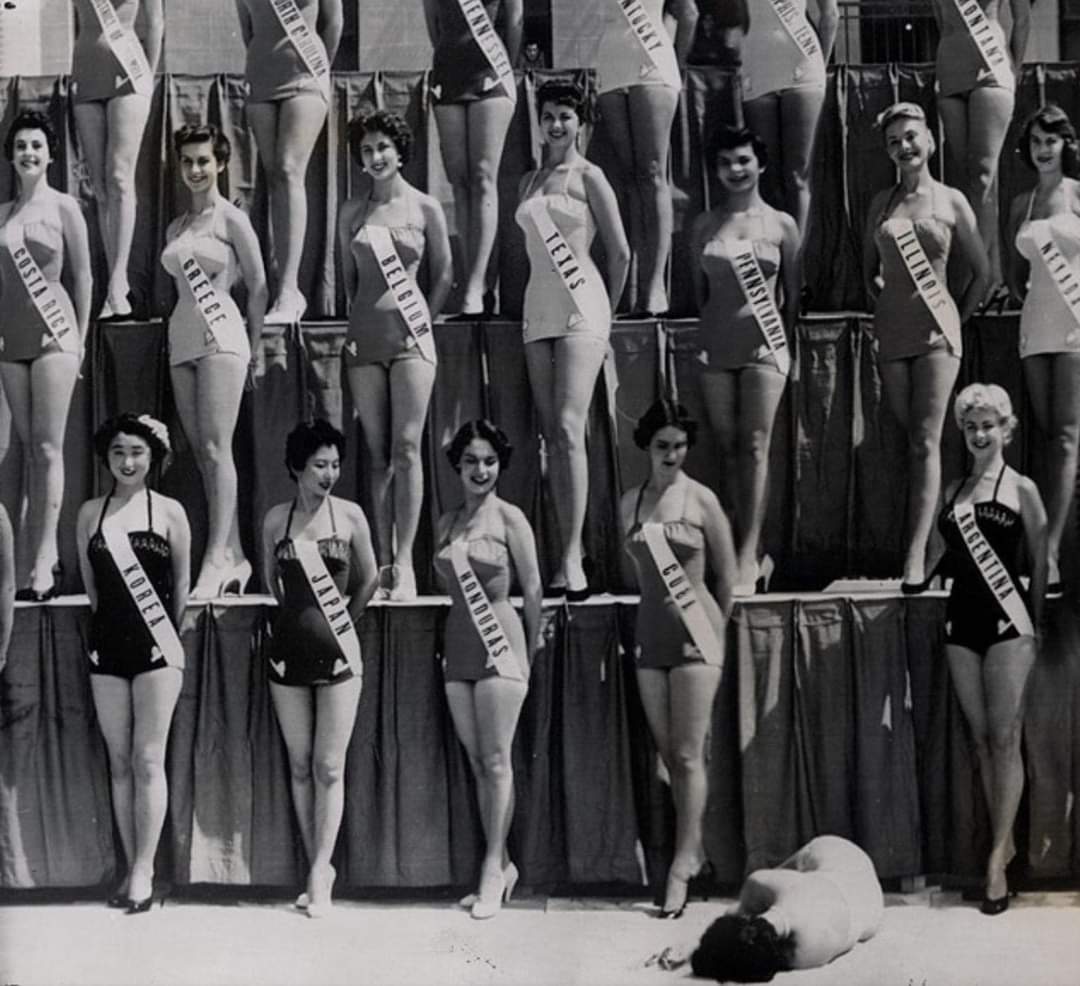In the first part of this analysis of hair removal, I explored the long and complex history that led to the emergence and normalization of this practice. In this piece, I first provide a snapshot of the scenario in India and then proceed to deconstruct the oppressive norm of feminine hairlessness by looking at it through a feminist lens.
Status quo in India
Today, hairless arms and legs are considered the ‘sexy’ norm, which serves as a status symbol of the society you come from. Having hair on your arms and legs is seen as somewhat ‘dirty’ and adhering to the compulsion of stripping off body hair is a sign of being ‘well-groomed’. Indians, much like other parts of the world, have entirely bought into the seemingly inextricable link between gendered notions of hairlessness and femininity. A survey containing questions on a woman’s visible body hair include responses that exemplify this. A 40-year old man in Noida said, “Fir aadmi jaisa ho jayga, automatic acha nai lagta” (It’ll be similar to a man then, and automatically it doesn’t seem fitting/look nice), and that “Baal sundar lagne ke liye hatate hain, jaise admi khud hee shave karta hai” (Hair is removed for looking beautiful, it is similar to a man shaving).
Even feminists, aware of the complex paradigm that surrounds the compulsion to remove body hair struggle to break away from this seemingly unbreakable notion of a hairless ideal. Anoushka Agarwal puts together a fantastic set of personal accounts of women that document their experiences with the pressure, bullying, coercion that surround hair removal.
In India, the ritual of removal of body hair (usually waxing) starts around the age of 14-15, when the young girl goes to the salon for the first time. The process of waxing is time-consuming, expensive and most of all, painful.
It is not uncommon for girls with body hair to be bullied in school, by girls and boys alike. Never mind the fact that they are only 12 or 13, an age where the skin might be too sensitive to undergo the harshness of waxing or that of a razor. They could have Polycystic Ovary Disorder (an exceedingly common condition in girls today, one of the many symptoms of which may be excessive hair growth).
People will freely comment on the hair on a woman’s arms and legs, destroying the ideas of body positivism and acceptance. It doesn’t matter if the wax gives her allergic reactions, or makes her yelp in pain, or even burns her skin. She cannot choose to exercise agency over her own body. After all, women “shouldn’t” have body hair.
Waxing restricts what we can and can’t wear. Our cycles of repetition of clothes are based entirely on our waxing schedules. It forces us to answer ridiculous thoughts such as, “Can I wear shorts, or must I cover the hair on my legs?” The possible peek of that black stubble on our legs frightens us, being aware of the disapproving gaze that comes our way. Hair is perfectly normal for a boy, preferred even. But somehow, it is unnatural and “unbecoming” for a woman? Why is hair treated as something so ghastly when found on a woman’s body?
It is not uncommon for girls with body hair to be bullied in school, by girls and boys alike.
A feminist take on hair removal
Over the years, patriarchy has demanded hairlessness as a feminine ideal. Firstly, this was a direct result of the pre-pubescent/school girl fetishes emerging at the time, which encouraged the ‘hairless’ look. It indulged in patriarchal standards that saw feminine and submissive as synonyms. Secondly, it was a way of affirming the sexual difference between the two dominant genders. As noted by Darwin, “loss of hair” was seen as a direct result of evolution. While women grew the hair on their head, they shaved off their hair to appeal to men, using it as ‘sexual selectors’. Society viewed a woman with ‘excess’ body hair as not only hideous and ludicrous but also as someone who showed signs of degeneration.
Today, hair is a feminist issue. The choice to keep body hair isn’t merely a personal choice, but a political statement. A woman with visible body hair is seen as ‘disobedient’ or ‘rebellious’. Body hair became a feminist issue in 1970s America, marked by the uproar over diminishing amounts of pubic hair for girls in pornographic material. Which primarily stemmed from the desire to infantilize the models, in line with the desire to see women as ‘fragile’, ‘delicate’ and ‘yielding’.
It is absolutely outrageous that women spend so much time, money and effort to rid their body of something it grows naturally every day. Not because they want to, but because they have been instructed to and because they are expected to. This oppressive norm convinces women that they must change their bodies in order to be attractive has now become a rite of passage.
Women start removing body hair when at the brink of puberty. They are told, “it is the thing to do”; and continue to do so to strive by the ‘hairless ideal’ (a term borrowed from Susan Basow’s work). Rarely (if not never) will a woman say that she shaves for functional reasons such as discomfort or hygiene (the latter is debatable regarding underarm hair).
Visible body hair acts as a gender identifier. For instance, being hairless is seen as a sign of cis-gender heterosexuality in women, an identity that comes with its own hierarchical politics in relation to women who identify otherwise. Body hair can be a reason for ostracization for the woman defying the norm, who will be perceived as somehow ‘less-than’.
Further, body hair is used as a class identifier and becomes an issue of group membership, and/or identity, rather than remaining as simple as a personal choice. Lack of body hair is seen as a ‘class-marker’, such as clear skin, good teeth and certain styles of dressing. Associate Professor Breanne Fahs of Arizona State University conducted a 10-week experiment: she asked all her female students to stop removing body hair and all the male students to remove all body hair from their neck down and for each of them to maintain a journal where they would jot down their experiences.
Also Read: The Stigma About Body Hair – What’s The Big Deal?
As Fahs puts it, “There is no better way to find out about social norms, than to violate it, and see how people will react”. Many women reported that they internalized feelings of ‘dirty’ and ‘disgusting’ and experienced anger, backlash, homophobia and heterosexism from their family, partners and society. Notably, some women experienced this more harshly than others: a working-woman of colour would be the recipient of greater social penalties, as compared to an upper-class white woman.
As Niloufar Haidari points out, the pressure to remove body hair for women of colour (primarily Latin America, the Middle East and South Asia) is more than just ‘the hairless ideal’ – it is an attempt to assimilate into white culture. For instance, in Iran, being hairless is a status symbol that expresses that you are well off, take good care of your grooming, and are more ‘modern’ or Western. Fahs’ research shows that women prefer to talk about hair removal as a choice. However, they fail to address the complexities of that choice.
While reaching for that razor may seem like a free choice, it is rarely ever so. It is governed and dictated by years of internalization of smooth skin as the ideal quality, learnt from those who we consider our idols of beauty standards – celebrities, either in advertisements or on the Big Screen. It is disheartening to note that women themselves police and judge each other by the amount of hair they have on their legs.
There is an imminent need to stop oppressing each other, see this patriarchal practice for what it really is and break away from it. While patriarchy does have bigger symptomatic problems, they all stem from the idea of agency and respect for human dignity. Hair removal is routine to the extent where an engagement may be viewed as trivial. The negative reactions of society to a woman’s non-adhering to this reflects the immense power with which it shackles us.
From personal experience, I assure you that it is liberating to walk around in shorts or sleeveless tops with hair, knowing full well that people can see the hair and are probably judging me. It is liberating because their negative opinions fail to colour my perception of self, as I walk around completely comfortable in my own skin (and hair!). It makes me feel more in command of how to see myself and increases my self-confidence. I feel ecstatic when someone asks me why I don’t wax because it gives me a chance to introduce to them to a carefree world of wearing what you desire, without having to look at the amount of hair on your legs, where you are in charge of your self-image, where you don’t have to succumb to the societal pressures.
Next time someone comes and asks you why you haven’t waxed, cross-question them and ask them why they wax. Is it because they personally like feeling their own smooth skin, or is it because they are conscious of how other people see them? If it is the former, then clearly, it is the personal agency that is given primacy, in which case it should be none of their business why you don’t wax. If it is the latter, then perhaps, they see the problem but refuse to recognize it.
The choice to keep body hair isn’t merely a personal choice, but a political statement.
However, none of what has been stated above goes to claim that hair removal and feminism are at polar ends. One can be a feminist and still remove their body hair, as it is ‘free choice’ that lies at the heart of feminism. While hair removal in itself is not wrong, being compelled to do so by a third person is wrong. Some people, irrespective of social construct and gender, may be willing to put in the requisite time and effort of hair removal because they like the feel of their smooth skin. The key is to be true to oneself as to the real reason why one is reaching for that razor.
A ray of hope – conclusion
Today, the situation is improving, albeit it is geographically restricted to a few pockets here and there. Women have started talking about body hair, the need to do away with this social compulsion and have started embracing their natural selves. This has even seeped into pop culture, with public figures such as Miley Cyrus, Madonna, Paris Jackson, Bella Thorne, Beyonce, Halle Berry, Beyoncé and Julia Roberts unabashedly showing off their body hair, either on their social media posts or on the Red Carpet.

Another source of inspiration is Ayqa Khan, a Pakistani-American photographer and digital artist, known primarily for her work where she depicts South-Asian women bearing body hair. Xiao Meili, a 25-year old feminist in China, started a competition on the Chinese social media platform, Weibo, in which women were asked to share pictures of their body hair, aimed at challenging gender roles and oppressive beauty standards. She believes that “women should have the right to decide how to deal with their bodies, including small details like armpit hair”.
In India, 22-year old, Delhi based Naina Kataria was called out by her date for being “too much of a feminist” because she pointed out that ads for razors should not be endorsed by celebrities, as they further hairlessness as an aspirational standard. Stunned by the realization of how men do not understand the troubling extents to which a woman goes through every day just to appear “more presentable”, she proceeded to pen a poem, dauntingly revealing the hypocritical standards and conceptions of a woman’s beauty.
Women have come out in solidarity, to stand up for themselves against these restrictive social norms. Recently, they started a movement on Instagram, under the hashtag, #FreeYourPits, where they put up photos proudly showing off their armpit hair.
Things seem to be improving in very small parts of the world, where the privileged have the power and ability to defy norms, with the threat of considerably lesser social backlash. In large parts of the world, the compulsion remains stronger than ever. For instance, most women in the Middle East still cannot dream of abstaining from the practice of hair removal and choosing to sport feminist body hair.
Therefore, there is a need to fuel the movement to ensure it gains more traction. If we all resolve to look at the world around us with a more critical eye, we can break the social constructs that hinder us every day and take patriarchy down. After all, feminism is the future. Rather than making hairy legs uncool, let’s make emancipation cool.
I am Joysheel, a 20-year-old cis female, who willingly chooses not to remove my body hair. I have (a lot of) hair on my arms and legs that I refuse to strip off with hot wax. I am hairy and proud.
Also Read: Reclaiming My Body With Every Alteration Of It
Joysheel is a 4th-year law student at O. P. Jindal Global University, interested in international law and gender studies.
Featured Image Credit: Feministing





Hairy armpits are the very highly pleasure point places to attracting the males with a fantastic moody smell. Thanks to ur work.